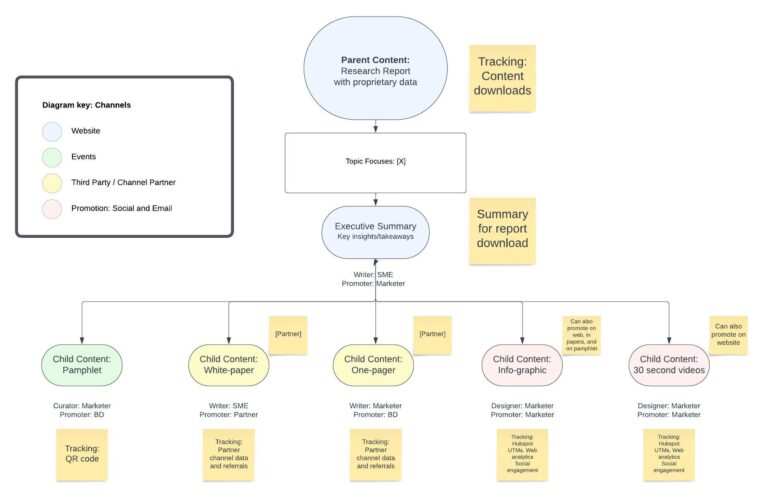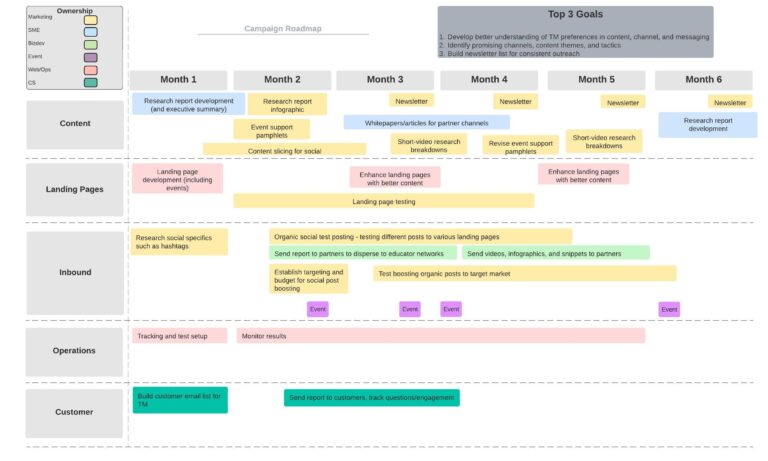By Sarah Threet, Marketing Consultant at Heinz Marketing If you are trying to get off the ground with a new product or program but you have very few resources to develop new content for a fully fleshed marketing campaign,...
By Sarah Threet, Marketing Consultant at Heinz Marketing
If you are trying to get off the ground with a new product or program but you have very few resources to develop new content for a fully fleshed marketing campaign, using a content taxonomy is a great strategic way to optimize what you have and make more with less in the short term.
What is a Content Taxonomy?
A content taxonomy is a system that helps with categorizing and organizing content. It makes it easier to prioritize content, connect the right content to the right audience, and seamlessly deliver content across multiple channels. It also makes it easier to repurpose content so that for every new marketing campaign, there doesn’t always need to be a huge lift to develop a lot of new content.
A taxonomy does this through structure (models and templates), metadata (tagging) and controlled vocabulary to ensure consistency in tagging and ease attribution.
The type of content taxonomy we will dive into in this blog is called a hierarchical taxonomy. These taxonomies are organized into parent-child relationships with each parent having one or more child categories. The parent content is the main piece of content and the child content are the pieces of content that can be developed from the main parent content. We have an example to illustrate later in the blog.
Tagging is usually seen in faceted taxonomies, which allows content to be broken down into multiple dimensions and organized by metadata and category. The use of taxonomy facets are helpful for content managers and digital asset managers who have other workflow tasks, such as identifying records with engagement, retention status, audience or market, and source.
The Importance of Having a Taxonomy
The primary purpose of this blog is to discuss how to use a taxonomy to make content operations more efficient and easier to scale, but there are many other benefits.
Having a content taxonomy will improve user experience; it helps users find the information they are looking for quickly and easily. According to Content Science Review, content is 53% less effective for people who had trouble finding it. They found having this experience can distort customer perception of the accuracy, relevance, and usefulness of the content.
A taxonomy helps organize website navigation, optimizes internal and external search functionality, improves segmentation and personalization, and analyzes performance reporting.
Implementing a Hierarchical Content Taxonomy
Circling back to the primary issue: often we do not have enough lift to develop a bunch of new content for a new product or program, so it’s important to know how to prioritize content. One of our clients was experiencing this very issue.
Originally, when we presented a fleshed-out campaign strategy, they felt overwhelmed as to how they would have the resources to implement it. They only had one business development manager, who was primarily focused on outbound and making connections, one marketer, one operations person, and a few subject matter experts for contract work.
We needed to simplify and prioritize! Unfortunately, the content audit did not provide many pieces we felt could be repurposed for this particular campaign – though some of them could be reframed and compiled into downloadable resources/guides. They needed to create something new and go from there.
The advantage this client had is they have a lot of proprietary data on their product and how it positively affects their audience. Combined with the unique backgrounds of their subject matter experts, we recommended they develop a research report, using their proprietary data, as their parent piece of content. Since most of the client contacts we were working with were not marketing people, we thought it best to develop a visual representation of how to break down this parent piece of content and deliver the child pieces across different channels.
 (This is the hierarchical diagram we provided to the client with client-specific info removed.)
(This is the hierarchical diagram we provided to the client with client-specific info removed.)
This taxonomy illustrates what child pieces of content can be made from the primary research paper (parent content), the channels for distribution, the responsibility of development and distribution for each piece, and how to track the performance of each piece.
This is just a small portion of the overall campaign strategy we provided and it provided an excellent starting point so they could begin marketing their new program without having to have all their content developed first. This allows them to build the plane as they fly it and begin to gather insights into what resonates so they can optimize their campaign as they implement it.
To further help with prioritization, since this diagram doesn’t illustrate which child content to create first, we also developed a 6-month road map.

(This is the 6-month road map we provided to the client with client-specific info removed.)
Conclusion
In conclusion, implementing a hierarchical content taxonomy offers a strategic solution for organizations facing resource constraints in their content development efforts. This systematic approach to categorizing and organizing content not only streamlines the content creation process but also provides a foundation for efficient scalability.
A content taxonomy, particularly the hierarchical variant discussed in this blog, allows businesses to repurpose existing content effectively and prioritize the development of new material for targeted marketing campaigns. The provided hierarchical diagram and 6-month roadmap served as invaluable tools, offering a starting point for our client to build and optimize their campaign iteratively. The hierarchical content taxonomy emerged as a powerful tool for maximizing content impact with minimal lift, enabling organizations to adapt and refine their strategies in real time.
The post Streamlining Content Development with Minimal Lift appeared first on Heinz Marketing.








